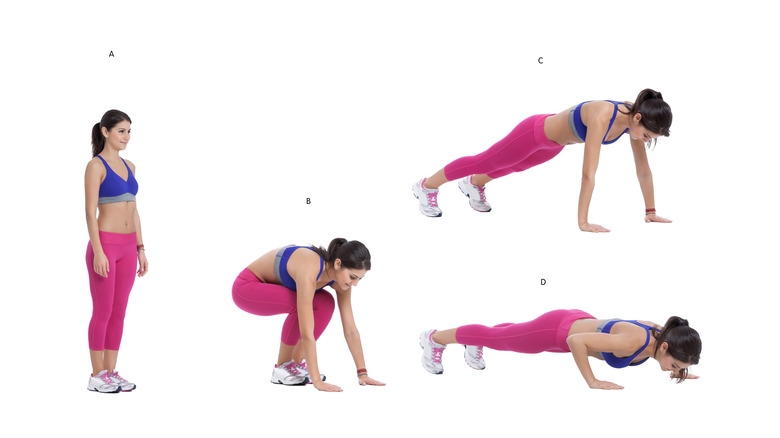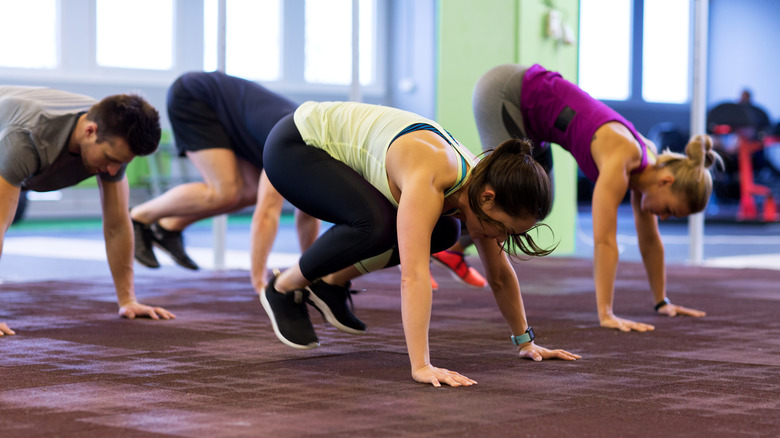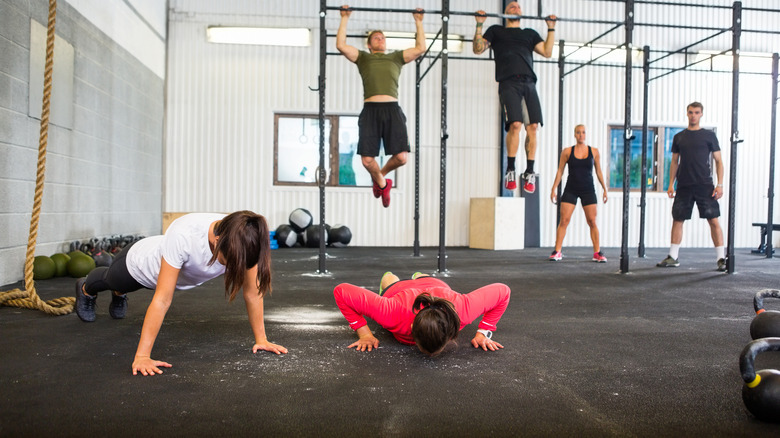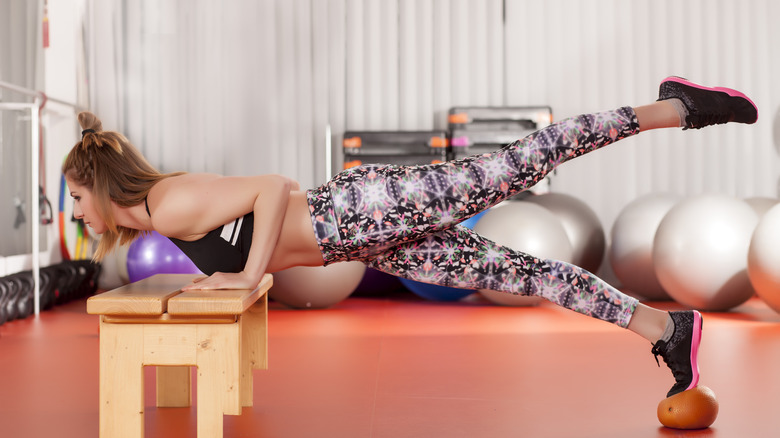Why Burpees Are King Of The Bodyweight Exercises
If you haven't heard of the burpee exercise, I'm going to assume you've been languishing in a 10-year coma. Glad to have you back.
To catch you up, burpees in their most basic form involve a series of movements that take you from a standing position into a plank position, then back to standing again. Even beginner-level sequences and modifications can be physically taxing, but in the last few years, sadistic personal trainers have gotten a hold of the exercise and turned it into a fast-paced, often varied, plyometric torture mechanism used to brutalize clients into better shape.
The exercise is tough, no doubt, but as a certified exercise physiologist with a master's degree in exercise science, I can also attest that it's effective, seating it rightfully as the king of bodyweight moves. Here's why.
The burpee is incredibly efficient
Space, equipment, and time are three of the most common barriers to exercise, and the burpee makes fast work of knocking all of these excuses down. Burpees require no equipment, almost no space, and a strikingly short amount of time when performed as part of a high intensity interval training (HIIT) protocol.
In fact, Julia Buckley, a personal trainer and author of the book, The Fat Burn Revolution, points to a 2014 study published in the Journal of Strength and Conditioning Research that compared the effectiveness of burpee interval training with sprint training on a bicycle, "This study compared the metabolic effects of high intensity cycling and rapid burpee reps performed in 30-second intervals. Both exercise protocols elicited similar cardiovascular responses, but unlike cycling, where most of the work is concentrated in the lower extremities, burpees elicit a similar cardiovascular response while simultaneously incorporating upper body and lower body strength training without any equipment required."
Pretty great, right? But that's not all.
The burpee works everything
Burpees don't just work your whole body, they require all your muscles to work together as a single unit as you perform the burpee movement pattern. Ultimately, this type of compound exercise series helps you develop strength, power, agility, and coordination.
Christian Koshaba, a trainer at Three60Fit Gym outside of Chicago told me, "Burpees work your entire kinetic chain, incorporating a multitude of functional movements from jump and squat, to deadlift, to push and press. With advanced modifications you can achieve movement in all planes of motion — side to side (frontal), forward and backward (sagittal), and twisting and rotation (transverse)."
This means with regular practice, burpees can help you move better as an athlete, and really, just as a human being. Don't you want to be a better human being?
Burpees burn serious calories
Given that burpees work your entire body while eliciting a cardiovascular response akin to sprinting on a bicycle, it really should come as no surprise that burpees are big calorie burners. And if fat loss is a goal, you know you need to burn those calories.
Some estimates indicate burpees burn about 10 calories a minute — an amount similar to running at a 10-minute mile pace, but really, these types of blanket estimates are hard to pin down on an individual basis. Everyone's metabolism is different, so the specific number of calories you'll burn doing burpees is going to vary based on factors like height, weight, muscle mass, age, and gender. But this is what you need to know: A 2016 study referenced in the May/June edition of the ACSM's Health & Fitness Journal compared the energy expenditure (calorie burn) of 13 different exercises. Out of all 13 exercises, burpees ranked the second highest for calorie burn, losing only to intervals performed with a battle rope.
Also, a 2016 study that compared a 10-minute, whole-body HIIT workout consisting of barbell thrusters and burpees to a 20-minute moderate-intensity rowing workout found that the HIIT workout required longer recovery time and elicited a higher excess post-exercise oxygen consumption (EPOC), each of which points to increased calorie burn after your workout.
They're scalable for all fitness levels
Here's the thing: Burpees are hard. And because traditional burpees require you to move repeatedly from a standing position to a plank position, and often incorporate pushups and jumping, every variation isn't appropriate for every person. If you're new to doing burpees, or if you have limited range of motion, chronic pain or injuries, you'll need to modify the move.
Koshaba points out that it's not even necessary for people to go all the way to the ground to benefit from the exercise, "Someone with an injury and restricted movement can start by doing a push-up against a wall or on a raised surface, and instead of hopping their feet back to plank, they can alternately lift each leg in a knee bend before returning to standing." Gradually, these individuals can work their way to the floor, and only over time, should they add a push-up to the plank position, or a jump from the kneeling squat position.
So, yeah, you don't need to perform burpee acrobatics your first time to try the move. Instead, start slow, focus on form, and work your way up to more challenging variations over time.
How to do the full burpee
To do the most basic burpee, you start in a standing position, crouch down, place your hands on the ground under your shoulders and between your feet, hop or step your feet back into a plank position, pause, hop or step your feet back to their starting position, then return to standing. This is a basic burpee, and the one "invented" by Royal H. Burpee, an American physiologist, in the 1930s as part of a fitness test. These days, however, the "full" burpee — the one popularized by CrossFit — includes the following series of steps:
- Start in a standing position, feet roughly shoulder-distance apart, knees slightly bent.
- Squat down, placing your hands on the ground under your shoulders between your feet.
- Hop your feet back into a full plank so your body forms a straight line from heels to head. Keep your core tight.
- Bend your elbows and lower your chest toward the floor to perform a pushup.
- Extend your elbows and press yourself back up into the planks position.
- Hop your feet back towards your hands, and shift your weight into your heels, dropping your hips between your knees to a crouch position.
- From here, jump up into the air to perform a squat jump, clapping your hands overhead.
- Land softly, your knees and hips slightly bent to absorb impact.
It's usually this "full burpee," including the pushup and squat jump, that's modified to make the movement easier or more challenging.
Modifying the burpee for beginners
There's no reason to try a full burpee your first time out. One of the best ways to modify the movement is to remove all of the hopping, or plyometric motions, and to use a raised surface to place your hands on, rather than going all the way to the floor. For instance, if you have a sturdy bench, simply stand facing the bench, crouch down, placing both hands on the bench so they're aligned under your shoulders. Step your feet back, one at a time, so your body is fully extended forming a straight line from heels to head. Pause here for a second, keeping your abs engaged, then step your feet back, one at a time, to their starting positions, and stand up. Just like that, you've done a modified burpee.
Making the full burpee more challenging
Once you're knocking out full burpees like nobody's business, go ahead and add a challenge. One quick way to amp up the intensity is to stick with the basic burpee movement, but to remove one leg from the equation so you're performing the full burpee on only one leg. Start standing with your feet hip-distance apart. Shift your weight to your right leg and lift your left leg from the ground, so your weight is fully supported by your right leg. You're going to keep your left leg lifted throughout the exercise. Crouch down, place your hands on the ground under your shoulders. Hop your right leg behind you, so your body forms a one-legged plank, your left leg remaining off the ground. Add a push-up here, if desired. Hop your right leg back to its starting position, and when you're balanced, press through your right leg to return to standing, adding a single-leg hop at the end of the movement.
Quick tip: The first time you perform single-leg burpees, take your time and move slowly. Focus on form rather than speed. The exercise is much more challenging because it incorporates an element of balance and stability into the exercise, and the single-leg hopping exercise is particularly challenging if you're not accustomed to this type of plyometric training.
Get your heart pumping with box jump burpees
You can get your heart pumping even harder by trying a box jump burpee. This added challenge incorporates even more power into the exercise, as you have safely execute a box jump at the end of each burpee.
Start by standing behind a low box or sturdy bench. Perform the full burpee just as described above, moving from a standing position, into plank, performing a pushup, then jumping your feet back to their starting position. But this time, when you'd normally just jump into the air, you'll jump up onto the box, planting your feet securely on its center before standing tall. Step safely down off the box, then continue the exercise.
Programming burpees
Burpees are hard. They're not the type of exercise you do for 20 minutes straight as a form of moderate-intensity exercise. As such, you're better off incorporating them into your workout routine as part of a high intensity interval training routine or as a burst of tough conditioning work interspersed throughout a circuit training routine or a more low-key form of cardio. If you want to add some to your workout, consider the following ideas:
- Do a burpee Tabata routine. Use a Tabata timer to time you. During the eight, 20-second work intervals, perform a burpee variation of your choice. Rest during the 10-second rest intervals. If you don't have a Tabata timer, do eight rounds of five burpees, resting for a count of 10 between each set of five burpees.
- Walk with burpee intervals. Walk on a trail or treadmill for 30 minutes. Every two minutes, stop, do five to 10 burpees, then start again.
- Circuit training with burpee intervals. Choose any eight strength training exercises of your choice. For instance, squats, lunges, chest press, dumbbell rows, deadlifts, shoulder press, triceps dips, and biceps curls. Perform 12 to 15 reps of an exercise, and before proceeding to your next move, do 20 seconds of burpees, then immediately advance to your next exercise. Continue the circuit until you've completed all eight exercises. Rest for two minutes, then perform the circuit two more times.
Just remember, as you fatigue, you're more likely to ignore proper form and open yourself up to injuries. To prevent this from happening, continue modifying your burpee variation as you go, making the exercise less challenging the more tired you become. And of course, always listen to your body. If doing five to 10 burpees is just too much, add just one or two burpees in between exercises or sets. There's absolutely no need to overdo things or push yourself past your limits.





